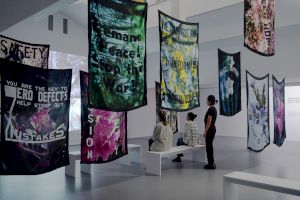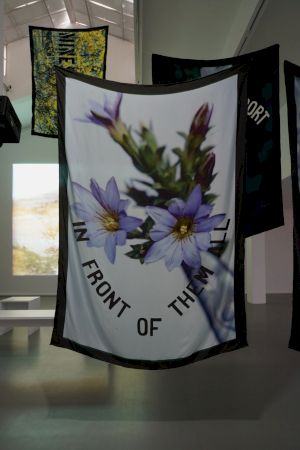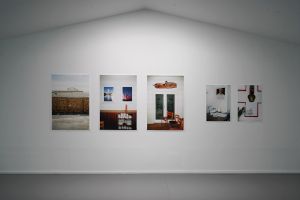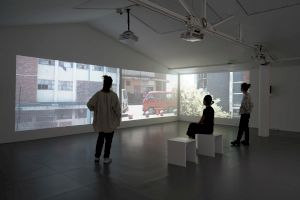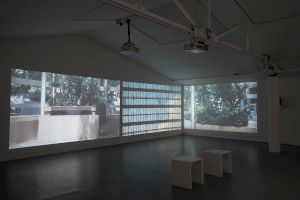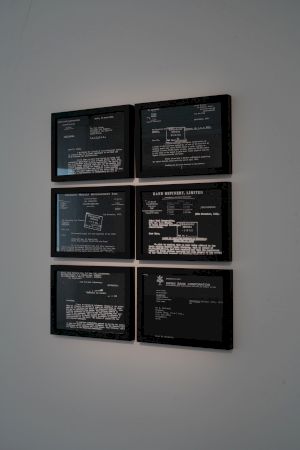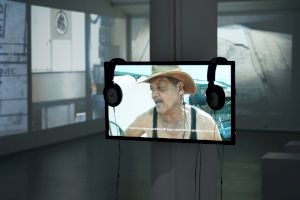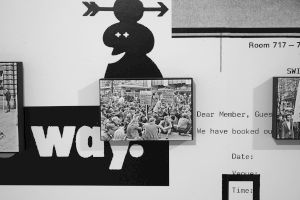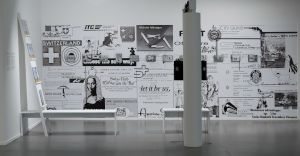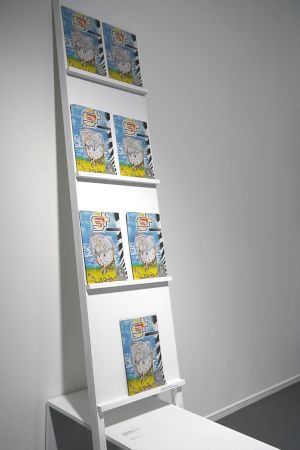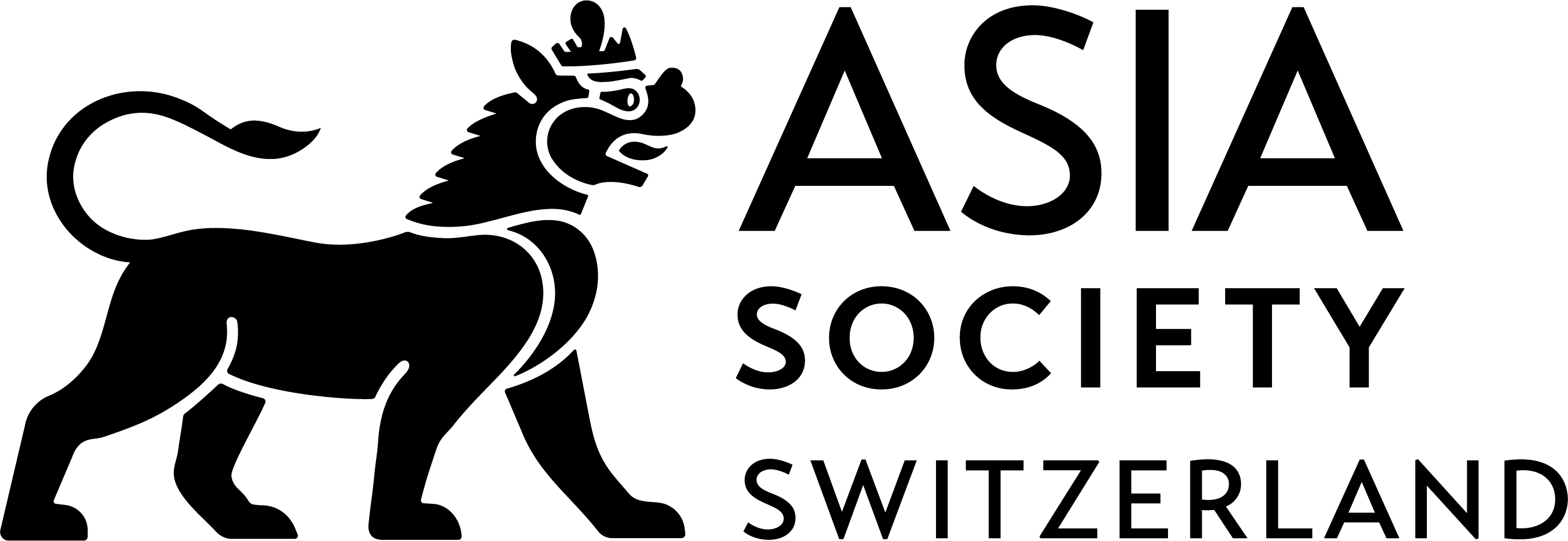Denise Bertschi
Oasis of Peace. Neutral Only On The Outside
MÉDIATION
Visite flèche : tous les week-ends, 16:00 (20’)
Curator tour jeudi 21 octobre à 17:00 (45’)
ÉVÉNEMENTS ASSOCIÉS
↘ Artist Talk avec Heonik Kwon (21.10)
↘ Artist Talk avec Denise Bertschi et Doris Gassert du Fotomuseum Winterthur (13.11)
À l’occasion de Nuit Blanche le 3 octobre l’exposition sera exceptionnellement ouverte jusqu’à 00:00
Cracks in appearances, representations out of step with reality, and gaps in historiography are all of interest to Denise Bertschi (*1983). The artist seeks in her work to render visible the links between Switzerland and global geopolitics. To this end, she retraces Swiss colonial entanglements and ambivalent relations in the world of economics, while calling into question narratives of nationalism and the notion of neutrality. Using the tools of historians, anthropologists, or investigative journalists, she creates installations and videos in which archival documents and personal photographs commingle with the narratives of the people she encounters and the findings of her own research.
The exhibition Oasis of Peace. Neutral Only On The Outside establishes unexpected links between Switzerland and two regions of major geopolitical importance: firstly, the demilitarized zone (DMZ) between North and South Korea; and secondly, apartheid South Africa. Switzerland has played its cards cleverly, in both cases, using to its own ends a “neutrality” that the historian Hans-Ulrich Jost has characterized as “self-serving“ and “dualist“.
All the work assembled (since 2014) under the title State Fiction (2014–2021) reflects the artist’s long-term research into the zone that divides the two Koreas, a locus of congealed international Cold War interests and a source of improbable images. After an internationally brokered armistice in 1953, the United Nations (UN) invited Switzerland to participate in the peacekeeping mission foreseen for the DMZ. Three other neutral nations were likewise present: Sweden represented the capitalist and anti-Communist Western bloc; Poland and Czechoslovakia, the Communist Eastern bloc. Armed Forces were then stationed extensively throughout the DMZ, and tasked to oversee the divided countries’ exchange of prisoners and arms. Following disbandment of the Eastern bloc, the mission was massively downsized, in part because North Korea spurned it in 1994, on the grounds that it no longer represented Communist interests. Switzerland nonetheless maintains a military presence there to this day. It was there, at the “Swiss Camp”, an at once idyllic, nostalgic, and absurd little island of “swissness”, that Denise Bertschi shot photos and videos during a trip in 2014. And it was there, too, long before her, that Swiss soldiers documented their daily lives and pastimes, their encounters with the local people, and their fascination with the Korean fauna and flora. This immense mass of images and films is now conserved in Bern, at the Library Am Guisanplatz (BiG) the main archive of the federal administration and the Swiss Armed Forces.
Devised especially for the exhibition, Bertschi’s new video montage consists entirely of such archive material. It reveals not only the gaze of these supposedly “neutral” soldiers— the way they regarded all that is “other”—but also, and above all, how, at the height of the Cold War, Swiss nationalism forged a narrative in which were fused both neutrality and a desire for power in the international arena. The video suggests, in effect, that Switzerland astutely seized upon this chance to improve its image, an image severely tarnished by the end of the Second World War; for while purporting to be neutral, the country had taken care to maintain its economic ties with Nazi Germany, to issue permits for the passage of German trains, and to impose extremely restrictive policy on Jewish refugees. To number among the four countries assigned a peacekeeping role in Korea was a welcome opportunity to renew relations with the leading international players, in particular with the USA, the living incarnation of the anti-Communist sentiment prevailing at the time among the Swiss.
The video State Fiction is shown amid art works suspended in mid-air: floral textiles on which have been printed slogans found in the Swiss Camp or in the surrounding Joint Security Area, which is under the jurisdiction of the United Nations Command (UNC). Inspired by the curtains typically found at the threshold of Korean households, they stand both for the barriers and links between exterior and interior spaces, delimiting thus the realms of public and private life. STATE FICTION. The gaze of a Swiss “neutral” mission in the Korean DMZ, edited by Denise Bertschi for this occasion, compiles within its pages several essays on the topic, as well as amateur photography analyzing the gaze of the Swiss on the divided Koreas from the 1950s to the 1980s.
Neutrality as an Agent is a further complex work series, collated in this case in the course of Denise Bertschi’s numerous trips to South Africa. Drawing on archives, architecture, the urban fabric, and local production of vernacular images, she first brought to light traces of history and delved into the self-serving ways neutrality is put to use. She pursued artistic research in a variety of media, from video and photography to collage; and not least in her acclaimed publication, We say we are fine. They say we are not, which was listed in The Most Beautiful Swiss Books Award 2019.
It’s a quite other type of Swiss enclave that Denise Bertschi came across in South Africa in 2018: the Swiss Social & Sports Club welcomes Cape Town’s Swiss ex-pat community and temporary visitors to sit back and relax, be they businesspeople, bankers, or financial experts. In her video, Please ensure the gate is properly closed (2018), the Club’s caretaker, John, tells the history of this private enclave—but, too, of racist discrimination he has faced there, over the years, from being accused of theft to being deprived of the keys; thus he is a caretaker yet with limited access!
This Swiss Club, its very existence, is perhaps the most caricatural proof of the close and continuing relations that Switzerland has maintained with South Africa since the earliest days of the Apartheid regime. Arms exports, banking maneuvers, gold mines, and Swiss bank loans were crucial to a regime regularly subjected to international boycotts (e.g. the arms trade resolution adopted by the UN Security Council in 1977 and international campaigns such as that of 1983/4, to stop the IMF making loans to the country)—none of which Switzerland participated in. Yet despite this economic pressure and international policy, despite widespread recognition of the racist regime’s brutality and the mounting tension among South Africans and in Switzerland (the latter evident in Gertrud Vogler’s photographs of anti-Apartheid protest marches, which Denise Bertschi represents), the Swiss government and Swiss companies never ceased to invoke neutrality and use smokescreens to uphold the status quo. In 2003, even, the Swiss government commission tasked with investigating the country’s involvement in Apartheid found itself suddenly denied access to the federal archives—which says a lot about the nature of that involvement.
To get to the bottom of the story, Denise Bertschi took up research at the National Archives of South Africa, among other places, and there discovered two archive boxes with correspondence from the 1950s concerning the gold trade dealings of the Société de banque suisse (SBS; now UBS). She thereupon chose to pay a personal visit to the site of these transactions. The video Confidential (2018) thus constitutes a cartography of six buildings in Pretoria or in Johannesburg’s former Central Business District (CBD), which at the time of the veritable “goldrush” seemed destined to become an entirely white “African New York City.” We glimpse glass and concrete facades, and the old signs of businesses that have long since relocated or been abandoned for good—but above all, we sense the striking absence of a history carefully buried behind the official version of the past.
Close-ups of rhododendrons and geraniums, of mountains and hills on the horizon, of architectural walks in derelict modern buildings: the photography and video work of Denise Bertschi, with its almost banal or even cryptic images, may well deceive. Yet these images are haunted by what lies beyond the lens, outside of the frame, by all that is going on, or once happened, just to the side of the neat flowerbeds, somewhere between here and those distant hills, or behind those locked and bolted doors. Denise Bertschi takes the pulse of these places and material traces so as to fly in the face of willful oblivion; she turns the images of wishful innocence inside out, to better dissect the often so conniving construction of news and views.
— Claire Hoffmann
Translation : Jill Denton
bio
Denise Bertschi (*1983 Aarau/CH) is an artist-researcher, working at the intersection of art, history and cultural memory. She holds an MA in Visual Arts from HEAD Haute Ecole d’Art in Geneva and a BA from Zurich University of the Arts ZHDK. She is currently working on a PhD thesis at EPFL Lausanne in the „Arts of Sciences Laboratory“, in collaboration with HEAD – Genève. Her first monograph „Denise Bertschi. STRATA. Mining Silence“, was published on the occasion of the Manor art prize, awarded to her in 2020 by the Aargauer Kunsthaus. International exhibition activities and research took her to Brasil, South Africa and Korea, places of geopolitical entanglements that she weaves into Swiss historiographical memory and questions them on coloniality. Denise Bertschi’s investigative practice translates into academic, as well as artistic forms through the use of media such as film, photography or installations.
Her work has been shown in diverse institutions in Switzerland and elsewhere: in the Aargauer Kunsthaus, the Johann Jacobs Museum in Zurich, LACA Los Angeles, the Museum für Kunst und Gestaltung MKG in Hamburg, RosaBrux Brussels, Artsonje Center Seoul, WITTS University in Johannesburg or Corner College in Zurich.
She got awarded with the Manor art prize in 2020 at the Aargauer Kunsthaus, the Most Beautiful Swiss Books award (2019), a research grant by the Getty Research Institute GRI in Los Angeles (2019) and a nomination for the Swiss Art Awards in 2019. Together with Dunja Herzog, she was shortlisted for the Swiss Pavilion of the 59th Venice Art Biennale. Various project contributions from Pro Helvetia, the Aargauer Kuratorium funded her artistic research. Currently she is an artist in residence at CAN Centre d’Art de Neuchâtel, followed by a residency at La Becque in autumn 2021.
Publication
Une publication intitulée STATE FICTION. The Gaze of the Swiss Neutral Mission in the Korean Demilitarized Zone et éditée par Édition Centre de la Photographie Genève (Joerg Bader) rassemble les recherches approfondies que Denise Bertschi a menées dans les archives militaires, de nombreuses photos et films issus de la
DMZ en Corée, ainsi que des essais de Hans-Ulrich Jost (historien spécialisé
dans le concept de neutralité en Suisse), de Heonik Kwon (anthropologue
coréen spécialisé de la partition de la Corée) et de Denise Bertschi.
Publication : Édition Centre de la Photographie Genève (Joerg Bader)
Conception et édition : Denise Bertschi
Graphisme : Nadja Zimmermann, NASK Genève (avec Alessandro Schino)
Copyright images : Koreaarchiv der Bibliothek am Guisanplatz Bern (CH)
Parution : septembre 2021
Pages : 320 pages
Auteur.e.s : Dr Heonik Kwon, Dr Hans-Ulrich Jost, Denise Bertschi
EN / ALL et insert du texte en FR

